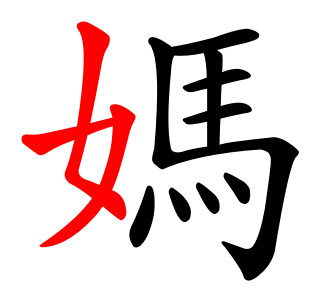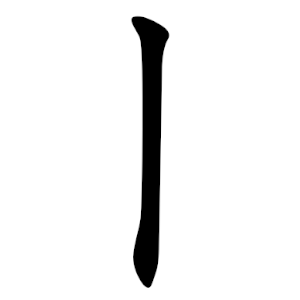Related Research Articles
Han unification is an effort by the authors of Unicode and the Universal Character Set to map multiple character sets of the Han characters of the so-called CJK languages into a single set of unified characters. Han characters are a feature shared in common by written Chinese (hanzi), Japanese (kanji), Korean (hanja) and Vietnamese.

A Chinese radical or indexing component is a graphical component of a Chinese character under which the character is traditionally listed in a Chinese dictionary. This component is often a semantic indicator similar to a morpheme, though sometimes it may be a phonetic component or even an artificially extracted portion of the character. In some cases the original semantic or phonological connection has become obscure, owing to changes in character meaning or pronunciation over time.

Shuowen Jiezi is an ancient Chinese dictionary compiled by Xu Shen during the Eastern Han dynasty. Although not the first comprehensive Chinese character dictionary, it was the first to analyze the structure of the characters and to give the rationale behind them, as well as the first to use the principle of organization by sections with shared components called radicals.

GB 18030 is a Chinese government standard, described as Information Technology — Chinese coded character set and defines the required language and character support necessary for software in China. GB18030 is the registered Internet name for the official character set of the People's Republic of China (PRC) superseding GB2312. As a Unicode Transformation Format, GB18030 supports both simplified and traditional Chinese characters. It is also compatible with legacy encodings including GB2312, CP936, and GBK 1.0.
The CNS 11643 character set, also officially known as the Chinese Standard Interchange Code or CSIC, is officially the standard character set of Taiwan. In practice, variants of the related Big5 character set are de facto standard.

Mojikyō, also known by its full name Konjaku Mojikyō, is a character encoding scheme. The Mojikyō Institute, which published the character set, also published computer software and TrueType fonts to accompany it. The Mojikyō Institute, chaired by Tadahisa Ishikawa (石川忠久), originally had its character set and related software and data redistributed on CD-ROMs sold in Kinokuniya stores.
The 214 Kangxi radicals, also known as Zihui radicals, were collated in the 18th-century Kangxi Dictionary to aid categorization of Chinese characters. They are primarily sorted by stroke count. They are the most popular system of radicals for dictionaries that order characters by radical and stroke count. They are encoded in Unicode alongside other CJK characters, under the block "Kangxi radicals", while graphical variants are included wit in the "CJK Radicals Supplement".
The Chinese character description languages are several proposed languages to most accurately and completely describe Chinese characters and information such as their list of components, list of strokes, their order, and the location of each of them on a background empty square. They are designed to overcome the inherent lack of information within a bitmap description. This enriched information can be used to identify variants of characters that are unified into one code point by Unicode and ISO/IEC 10646, as well as to provide an alternative form of representation for rare characters that do not yet have a standardized encoding in Unicode or ISO/IEC 10646. Many aim to work for Kaishu style and Song style, as well as to provide the character's internal structure which can be used for easier look-up of a character by indexing the character's internal make-up and cross-referencing among similar characters.
A Unicode font is a computer font that maps glyphs to code points defined in the Unicode Standard. The vast majority of modern computer fonts use Unicode mappings, even those fonts which only include glyphs for a single writing system, or even only support the basic Latin alphabet. Fonts which support a wide range of Unicode scripts and Unicode symbols are sometimes referred to as "pan-Unicode fonts", although as the maximum number of glyphs that can be defined in a TrueType font is restricted to 65,535, it is not possible for a single font to provide individual glyphs for all defined Unicode characters. This article lists some widely used Unicode fonts that support a comparatively large number and broad range of Unicode characters.
The Chinese, Japanese and Korean (CJK) scripts share a common background, collectively known as CJK characters. During the process called Han unification, the common (shared) characters were identified and named CJK Unified Ideographs. As of Unicode 15.1, Unicode defines a total of 97,680 characters.

Andrew Christopher West is an English Sinologist. His first works concerned Chinese novels of the Ming and Qing dynasties. His study of Romance of the Three Kingdoms used a new approach to analyse the relationship among the various versions, extrapolating the original text of that novel.

The 1615 Zìhuì is a Chinese dictionary edited by the Ming Dynasty scholar Mei Yingzuo. It is renowned for introducing two lexicographical innovations that continue to be used in the present day: the 214-radical system for indexing Chinese characters, which replaced the classic Shuowen Jiezi dictionary's 540-radical system, and the radical-and-stroke sorting method.

Radical 2 or radical line (丨部) meaning "vertically connected" is one of 6 of the 214 Kangxi radicals that are composed of only one stroke.

Radical 213 meaning "turtle" is one of only two of the 214 Kangxi radicals that are composed of 16 strokes.
In the Unicode standard, a plane is a continuous group of 65,536 (216) code points. There are 17 planes, identified by the numbers 0 to 16, which corresponds with the possible values 00–1016 of the first two positions in six position hexadecimal format (U+hhhhhh). Plane 0 is the Basic Multilingual Plane (BMP), which contains most commonly used characters. The higher planes 1 through 16 are called "supplementary planes". The last code point in Unicode is the last code point in plane 16, U+10FFFF. As of Unicode version 15.1, five of the planes have assigned code points (characters), and seven are named.

Radical 3 or radical dot (丶部) meaning "to indicate an end" is one of six of the 214 Kangxi radicals that are composed of only one stroke.
The Table of Indexing Chinese Character Components is a lexicographic tool used to order the Chinese characters in mainland China. The specification is also known as GF 0011-2009.
Kangxi Radicals is a Unicode block. In version 3.0 (1999), this separate Kangxi Radicals block was introduced which encodes the 214 radicals in sequence, at U+2F00–2FD5. These are specific code points intended to represent the radical qua radical, as opposed to the character consisting of the unaugmented radical; thus, U+2F00 represents radical 1 while U+4E00 represents the character yī meaning "one". In addition, the CJK Radicals Supplement block (2E80–2EFF) was introduced, encoding alternative forms taken by Kangxi radicals as they appear within specific characters. For example, ⺁ "CJK RADICAL CLIFF" (U+2E81) is a variant of ⼚ radical 27 (U+2F1A), itself identical in shape to the character consisting of unaugmented radical 27, 厂 "cliff" (U+5382).
References
- ↑ The Unicode Standard Version 6.2 (PDF). p. 435.
- ↑ The Unicode Standard Version 9.0 (PDF). p. 712.
- ↑ The Unicode Standard Version 6.2 (PDF). pp. 421–422.
- ↑ "Revised Proposal to Encode the Jurchen Characters in UCS" (PDF). 2012-01-26.